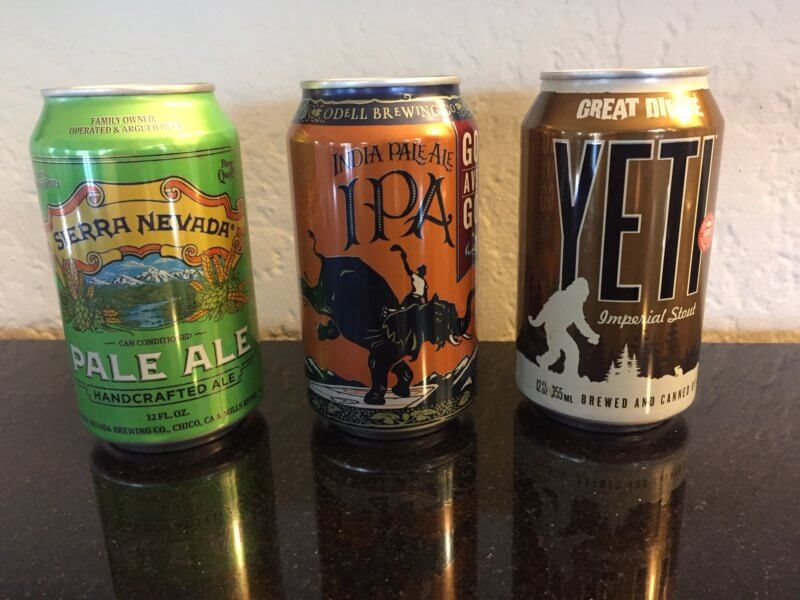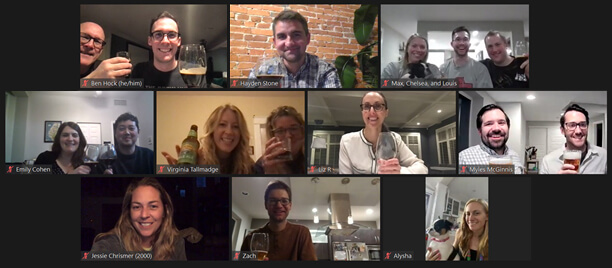Ben Hock took Colorado Academy Alumni and Alumni Parents on a beer-tasting journey April 7.
Beer enthusiasts attending included out-of-state alumni: Emily Cohen ’06 with her boyfriend Roger Timms from Chicago; Alysha Lascano Messmer ’01 from California; Hayden Stone ’09 from Washington, D.C.; and Ginger Tallmadge ’06 with her roommate Elizabeth from Knoxville. Locals joining the party were Jessica Chrismer ’00 with her father Denny; Ben’s father Doug Hock; Myles McGinnis ’08, with his brother-in-law Brett; Liz Robinson ’01, with her daughter Madeleine, who was tasting sparkling waters; Max ’08 and Chelsea Shaw, joined by Louis Talesnick ’08; and Zach Tucker ’01.
The beers were carefully curated by Ben and included Sierra Nevada Pale Ale, Cigar City Jai Alai IPA, Stone IPA, O’Dell IPA, North Coast Brewing Old Rasputin Imperial Stout, Pipeworks Lizard King, or Great Divide Yeti Imperial Stout, depending upon where participants lived.

The brews also demonstrated the latest in craft beer trends:
- American IPAs boasting citrusy, tropical, and piney hops flavors
- The revival of old styles like Russian Imperial Stout, with caramel and toffee notes
Ben also shared tips for pouring beer and appropriate glassware for each type, as he presented historical highlights about beer.
Some of Ben’s interesting historical beer facts:
- Almost as soon as humans settled in stationary civilizations and began harvesting grains, beer-like drinks were discovered, the result of a happy accident by farmers and water.
- The first recorded rice beer was recorded in China around 7,000 BCE, and the first barley beer in approximately 4,000 BCE in present-day Iran.
- Middle East trade routes brought the first beer to Europe, eventually establishing three brewing centers with their signature brewing styles in Germany, Belgium, and England.
- Meanwhile, indigenous Americans were already making their own very light beers using corn.
- American colonists brought their beer and brewing traditions to the New World. With beer being safer to drink than city water, the number of breweries proliferated to such a degree that there was one brewery for every 9,320 persons.
- During prohibition, many breweries survived by manufacturing other items, like ice boxes, corn, sugar, and tires.
- Canning beer began in 1935, leading to better storage and transport but less diversity. By 1978, there were only 78 breweries in the nation.
- President Jimmy Carter came to the rescue in 1978, signing a bill that legalized home brewing nationwide, which led to home brewers experimenting with recipes and then to commercial craft breweries.
- The leading pioneer was Ken Grossman, who founded Sierra Nevada in 1980. According to Ben, “His pale ale is widely celebrated as one of the first beers responsible for sparking the craft beer revolution because of its differentiation from other beer at the time.”
The Alumni Association thanks Ben for his extensive preparation, sharing his knowledge, and staying on for an extended period of time to answer everyone’s many questions.
For three alumni, Emily, Ginger, and Max, the party continued on FaceTime, with Walker Shaw ’06 joining the conversation.
Keep an eye on the Alumni Calendar for similar events in the future.
